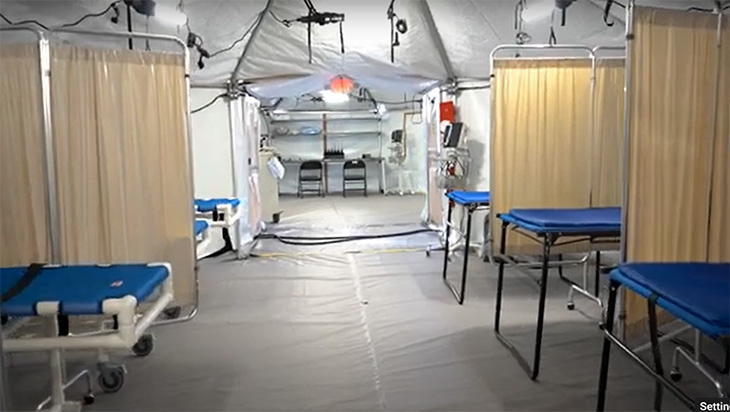UC Davis Health and the Department of Defense create prototype for temporary surge facility
Public health emergencies like the COVID-19 pandemic and recent international conflicts have revealed an important aspect of adequate and effective emergency preparedness: Hospital surge capacity is a prerequisite to ensure continued provision of health care services during disastrous and catastrophic events.
To help hospitals across the United States better prepare for the next patient surge emergency, UC Davis Health in collaboration with the Department of Defense has created a model for a temporary structure to respond to a future public health emergency.
“When a catastrophic event hits a community, there is often a large influx of emergency patients and health systems must have the capacity to support this patient surge,” explained Pranav Shetty, medical director of disaster management at UC Davis Health. “In events such as a natural disaster, mass shooting, overseas war or terror attack, hospitals have to make rapid decisions on how to appropriately manage the large influx of patients while providing high quality medical care for existing as well as incoming patients.”
In 2021, a total of 432 natural disasters occurred around the globe, claiming 10,492 lives and causing an economic loss of approximately $250 billion, according to a study in the international journal Public Health.
“Hospital disaster preparedness is crucial in achieving resilience to emergency situations,” Shetty said, “and healthcare facilities need to be prepared to deal with these events.”
Our goal was to provide a turnkey solution for any health care facility to deploy a surge facility to meet the needs of their patients following a surge event.”—Pranav Shetty
Creating a Modular Surge Facility
The project is formally called Improving Modular Patient Admission Capacity Through Scalable Solutions or IMPACTS. It is a pilot program in partnership with the National Disaster Medical System (NDMS) and the Defense Health Agency. It is funded through a grant from the Department of Defense.
The Department of Emergency Medicine has taken the lead on the project, with involvement of many other UC Davis Health patient care and operations departments. The team began the initiative by analyzing and defining the technical, operational, and staffing requirements to manage a health care surge across various scales of patient needs.
The team then began to design and create the 56-bed modular surge facility, or MSF, to address a future patient surge event. The structure includes a pharmacy, laboratory, radiology suite with X-ray and ultrasound capabilities. It also has a six-bed intensive care unit.
Next, the team deployed its design by building a sample MSF at a civilian hospital —UC Davis Medical Center was selected. Further testing will take place in a military setting at David Grant Medical Center on Travis Air Force Base in Fairfield.
The result of their work in Sacramento was a series of heavy-duty white tents on Vanderhoef Lawn.
“We sought out to create a facility that would allow a civilian or military health care organization to expand their patient care capacity in a short period of time,” explained Shetty. “This includes us providing the protocols and procedures to understand and deploy the operational capacities of the unit, as well as the clinical capabilities.”

Next steps for the IMPACTS Project
The team will now create a manual and training curriculum that describes the processes and considerations for deployment in a civilian and military healthcare environment.
“Our goal was to provide a turnkey solution for any healthcare facility to deploy a surge facility to meet the needs of their patients following a surge event,” Shetty said.
The manual and training curriculum will be produced in both a copy and video format for clinical and non-clinical staff audiences.
“It is an honor to work with the Department of Defense on such an important project like this,” said Shetty. “It is important for us to work together to create optimal solutions for the real hazards and emergencies we could see in the future.”






